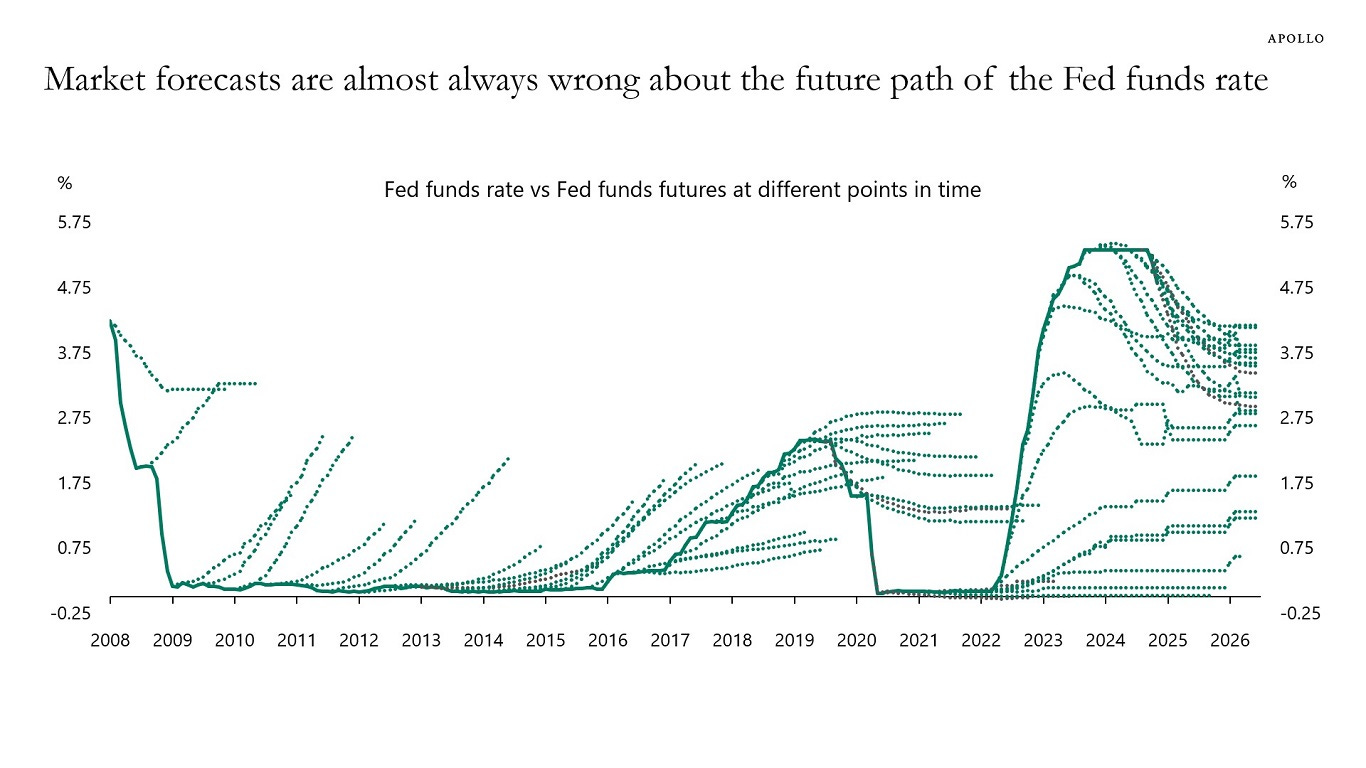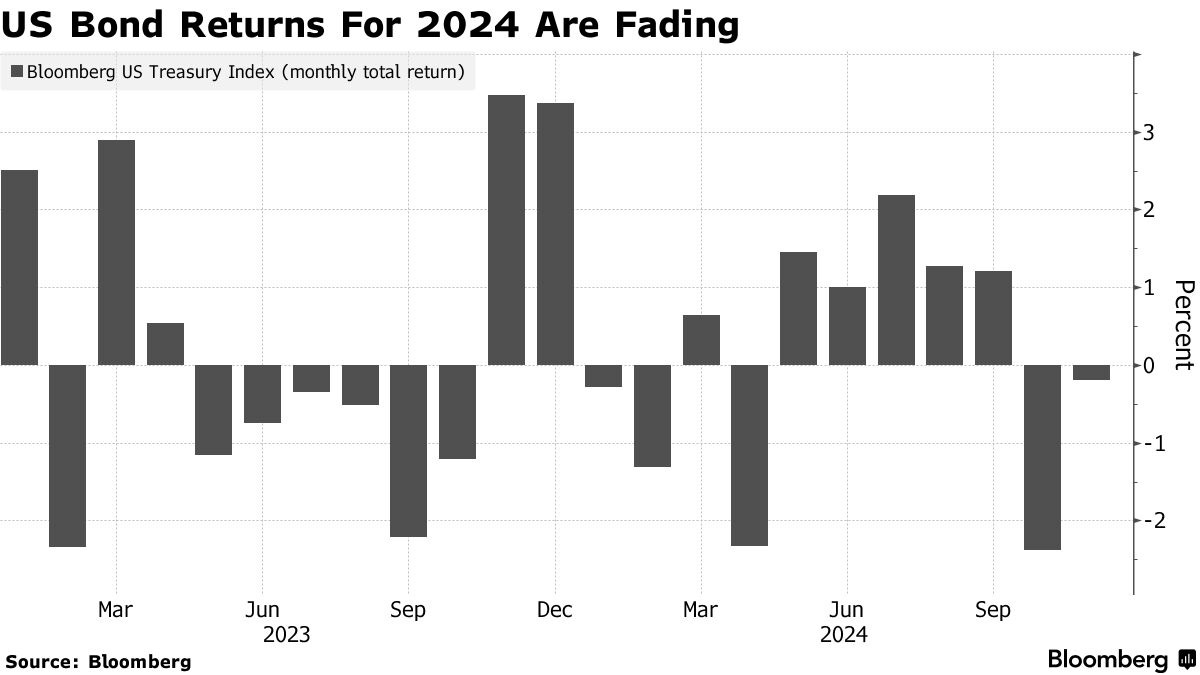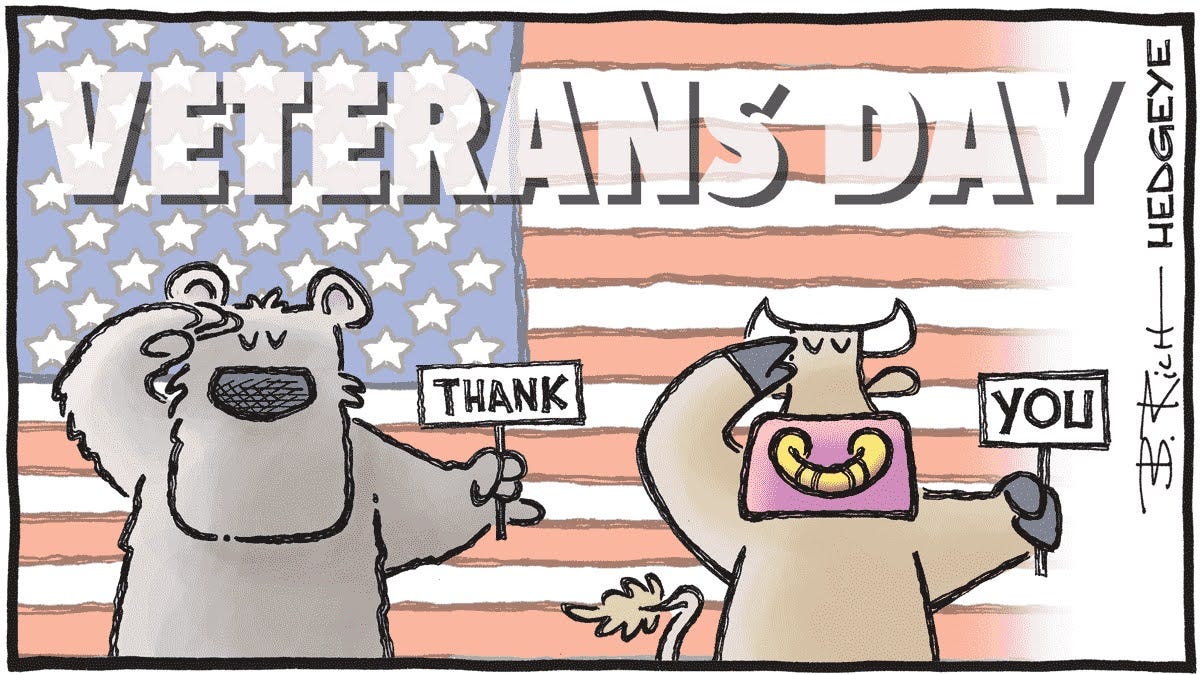while WE slept: USTs, Oil softer, eq, DXY BID, on thin, holiday trading; "Fed Expectations Are Wrong" -Apollo; 'US bond returns fading'
Good morning …
VA: History of Veterans Day
History.com: Armistice Day: World War I ends
History.com: Dedication of the Tomb of the Unknown Soldier
Thank you to all who served and your families, for all of your sacrifice … Freedom is not free. A special thanks to my (former)partner and dad, ret Navy
(is it me or, is that ‘Dixie Cup’ yuuuuuuge!?)
AND i’ll move along… with CASH bond markets closed, here’s an attempted look at futures via Trading View
ZN1: momentum improving, TLINE support holding …
… it’s different this time — rate CUTS marked with blue dotted line and 9/18, prices were HIGH and NOW, just days after the NEXT cut, prices adjusted lower and, well, it feels different this time … perhaps we priced IN Trump2.0?
… and with futures prices in mind all day as yields will NOT be avail, here’s an annotated run up in stocks (S&P500) as our collective love affair with round numbers (6000 ) continues …
source: Reuters
… here is a snapshot OF USTs as of 705a:
… and for some MORE of the news you might be able to use…
IGMs Press Picks: November 11 2024
NEWSQUAWK: US Market Open: Equites gain & DXY bid with the Trump Trade still at play; Crude slumps amid constructive geopolitical updates … Bonds are mixed, with Bunds firmer amid suggestions that Chancellor Scholz could bring forward a vote of no-confidence; Treasury cash trade is closed on account of US Veterans Day…USTs are slightly softer, paring some of the gains seen on Thursday/Friday which were largely a rebound from Trump-induced pressure on Wednesday. Note, conditions today are thin with the calendar sparse and Veteran’s Day meaning cash trade is closed. Currently pivoting the 110-00 figure, a move lower has support between 109-30 to 109-07 from last week.
PiQ Overnight News Roundup: Nov 11, 2024
Opening Bell Daily: Trump 2016 vs. 2024. 5 charts show how the Trump Trade moves markets: 2016 vs. 2024. Bitcoin and certain corners of the stock market have outperformed ahead of Trump's second term compared to his first.
Reuters Morning Bid: China caution cools sizzling US optimism
Finviz (for everything else I might have overlooked …)
Moving from some of the news to some of THE VIEWS you might be able to use… here’s SOME of what Global Wall St is sayin’ … First up, on China …
BARCAP China: Weaker CPI, persistent PPI deflation
Headline CPI came in weaker than expected, with core CPI and services CPI inflation staying modest despite marginal increases. We now expect full-year CPI to pick up at a slower pace of 0.3% y/y in 2024 and 0.8% the next year. PPI has been in deflation for 25 months, and the GDP deflator has fallen.
October: 0.3% y/y for CPI, and -2.9% y/y for PPI
Bloomberg consensus forecast (Barclays): 0.4% (0.4%) y/y for CPI, and -2.5% (-2.5%) y/y for PPI
September: 0.4% y/y for CPI, and -2.8% y/y for PPI
… much has been said and written about what comes with Trump2.0 and it’s likely to continue for … the foreseeable future and this one (from France)is as good as any …
BNP: Sunday Tea with BNPP: Preparing for Trump
KEY MESSAGES\
We view most of Trump’s probable policy proposals as inflationary and like owning US 5y breakevens.
A further widening in US growth and rate differentials to Europe suggests a lower EUR.
We see scope for additional inflows into the US equity market after the US election and remain bullish.
…The present valuation of US yields we thus think is priced on the “rumor” about what the near-term policy mix will be – with expansionary fiscal policy (aka tax cuts), hawkish trade policy and tighter immigration policy on the table. While all three carry inflation risks, only the fiscal expansion is likely to be beneficial for growth. The rise in real yields alongside breakevens suggests markets place more emphasis on an expansionary fiscal policy and less on tariffs and immigration (Figure 1).
Fig. 1: Rise in real yields and breakevens leading up to election
… AND just when you thought it was safe to go back in the waters and volMAgeddon has subsided …
DB: Weeks where decades happen
We interpret the US election as resulting in net fiscal easing, regulatory reforms, and the imposition of across-the-board tariffs. Consequently, we anticipate higher US long-term interest rates, lower front-end rates and a steeper curve in Europe, and most clearly, higher front-end rates in Japan.
There are, however, substantial risks around these preliminary views. Primarily, our initial assessment assumes that fiscal policy will ease in the US and remain initially tight in Europe. Arguably, though, there is little need for additional fiscal stimulus in the US and compelling reasons for Germany to utilise its fiscal policy space to address strategic challenges to its business model. Furthermore, China’s policy response to US tariffs could have implications for global inflation and, consequently, global rates. Lastly, the US election could result in a material shift in the Ukraine and Middle East conflicts, impacting energy prices and, in turn, inflation and the rates market.
Decades could happen in the weeks ahead. If the facts change, we will revise our views accordingly.
Meanwhile, our macro portfolio, already includes a long EUR front-end position (Dec-25 Euribor), a EUR2s30s steepener and a short position in the Japanese 2y to 5y sector. Adding a short SOFR 10Y position would be consistent with our analysis. However, given the seasonal flattening risk, we opt instead to be short the June 2026 SOFR contract, with an indicative target at 4.10% (which includes a modest risk premium) and an indicative stop at 3.60%.
…Higher US long-term rates, but ...
…Overall, our prior is to ascribe more certainty and immediacy to the tariff increases, additional fiscal stimulus via tax cuts, and regulatory reforms. In the scenario described by the Tax Foundation, we expect the additional fiscal policy easing to dominate, resulting in (a) an upward revision of the neutral rate, (b) the expectation that the Fed will need to remain above neutral for longer, and (c) higher term premia. A back-of-the-envelope calculation using plausible assumptions would be consistent with a UST10Y in the 4.5%–4.75% range. Note that regulatory reforms could result in more demand for US Treasury securities and an underperformance of SOFR rates. Lastly, US inflation breakevens should benefit from both additional fiscal easing and the imposition of tariffs. That is why, leading into the election we noted that the most asymmetric Trump trade was to be long US breakevens (1y2y in order to allow for the impact of tariffs to be reflected in the data). We do recognise, however, the need to adapt our view as we get more evidence of the timing and scale of the four policy levers (fiscal easing driven by tax cuts, higher tariffs, reduction in spending, and regulatory reform).DB: Mapping Markets: 4 Market Takeaways on the US Election
It’s been a historic week for US markets after the election. Risk assets are buoyant, with the S&P 500 at a new record, whilst credit spreads are incredibly tight as well, with IG spreads at their tightest since 1998, and HY spreads at their tightest since 2007.
But there are several takeaways we can glean from the outcome, some of which may give investors a bit more caution:
Inflation risks will mount further from here, given likely tariffs and fiscal stimulus. Plus the backdrop is already one where global central banks are easing policy, and growth data is increasingly surprising on the upside. So this is a prominent concern that could prompt a more hawkish reaction from the Fed.
The financial context is very different to Trump’s first victory in 2016. Fiscal constraints are much tighter given higher Treasury yields and a higher federal debt, whilst asset valuations are higher as well. So on paper, it looks harder to achieve the sort of rapid market gains seen after 2016.
Assuming we get unified government (which Polymarket places at 99%), the risk of another debt ceiling crisis has just collapsed for the next two years.
US politics is very volatile: In 9 of the last 10 presidential/midterm elections, at least one of the White House/Senate/House of Representatives has changed control. So it’s entirely plausible the political landscape changes quicker than many expect today.
… somewhat thematic and idea that now we know and SO, we should feel more ‘in the know’ but truthfully, we continue to know what we do NOT know …
DB: The Weekly Worldview: Fiscal Uncertainties
Fiscal policies are in focus after the recent elections.
In the weekly worldview last week, titled Election Foreshadowing, we highlighted the key policy questions of a new US administration: immigration, fiscal policy, and tariffs. For more perspective on these poilcy trade-offs, please see the US Economics team’s Friday Finish. In the weekly worldview this week, we retain elections as a theme but draw a comparison to the UK. We believe the experience of the UK, who recently proposed a new fiscal budget months after an election, is relevant, namely because of the time between taking power and the budget being presented. While markets are in the business of anticipating changes, the process of creating policy is often far more cumbersome. In a week where a lot of expectations have been priced in, we trace the process of forming policy in the UK to draw lessons for the US…
…The budget process for the US is less clear cut than in the UK, and deliberation and debate will likely happen over most of 2025. There is an additional question of how much revenue tariffs can generate on a sustained basis. History suggests that trade diversion tends to limit revenue gains. All of these facts suggest that the outlook for US fiscal policy will continue to evolve for some time.
… here’s another note (also from France) worth a look while the conclusion on USTs remains the same — look OK, but WAIT …
SocGEN: Fixed Income Weekly
A new way forwardWhat a week! With the US elections in the rear-view mirror, we look at how policies could shape our views on global bond markets. Bonds reversed the knee-jerk reactions postelections, as Treasury yields rallied, and Bunds sold off with the announcement of early elections in Germany. This divergence is unlikely to persist. As the year-end approaches we expect caution to prevail. Hence, we expect 10yT yield to stay in the 4.0-4.5% range and Bund 10y to remain close to 2.5%.
…With the elections now in the rear-view mirror we look for guidance on policies to shape our views on the markets. Bonds have almost fully reversed the knee-jerk steepening post elections, which was widely touted as the ‘Trump trade’. The spectre of widespread punitive tariffs contributed to the widening of inflation breakevens, but inflation expectation (around 2.4% across the curve) are still contained. Following the passage of this key risk event implied volatility declined sharply. Amidst the election news the new tranche of refunding supply and Fed’s 25bp rate cut passed with less fanfare. With strong data and sticky inflation the market is pricing-in fewer cuts than the median ‘dot’ for next year. As the year-end approaches we expect 10yT yield to remain in the 4.0-4.5% range, while the 2yT yield remains pegged.
Recommendations
While the recent sell-off could be a buying opportunity, we recommend waiting for volatility to subside before going long.…10y UST: potential hurdle at 4.49%/4.52%
10y UST has extended its up move after reclaiming the 200-DMA. It is challenging the trend line drawn since October 2023 and is in the vicinity of July’s peak of 4.49%/4.52%, which is a potential resistance zone. An initial pullback can’t be ruled out, but the MA near 4.19%/4.15% is an important support in the near term. Defence of this would be crucial for the up move to persist.If 10y UST establishes itself beyond 4.49%/4.52%, the phase of uptrend could extend towards next projections at 4.64% and 4.72%/4.74%.
… patience remains to be a virtue … so preservation OF your FI capital. okie dokie …
Makes sense and moving on …
… finally, from the Good Dr. Bond Vigilante himself …
Yardeni: The Economic Week Ahead: November 11-15
The week ahead will provide updates on inflation, consumer spending, and manufacturing. We expect inflation might have stalled in October, interrupting its decline toward the Fed's 2.0% target. We still expect a solid increase in inflation-adjusted incomes last month, which should fuel strong consumer spending. The goods sector likely remained depressed last month, especially as hurricanes and worker strikes weighed on manufacturing hours worked.
Here's what we're watching:
(1) Consumer inflation. October's CPI (Wed) should show that inflation stalled. The Cleveland Fed’s Inflation Nowcasting model projects that the headline and core CPI rose 2.56% and 3.34% y/y (0.18% and 0.27% m/m) last month. Weaker base effects (or lower y/y prints from a year ago) mean that monthly price changes will need to be weaker for disinflation to stay on track. The Fed has projected that the PCED inflation rate will reach 2.0% gradually over the next couple years, so bumps along the way may not disrupt the Fed's plan for further rate cuts.
Still, with CPI services inflation stuck around 4.5% y/y recently, the Bond Vigilantes may take matters into their own hands if overall inflation gets stuck somewhat higher than 2.0% (chart).
This first one is presented without commentary …
Apollo: Fed Expectations Are Wrong
The economy is strong, and there are upside risks to inflation. Markets are pricing in too many Fed cuts, see chart below.
… other than to say that FED EXPECTATIONS and longs (ie rentals) in 2s, 10s when conditions look promising — can and will live and peacefully coexist with one another.
This next story a good, topical look at week ahead and i’ll say that its headline struck me as something Capt Obvious might right … but with holiday tomorrow for bond jockeys, perhaps something to help pass the time …
Bloomberg: Bond Market on Risky Path as Traders Regroup From Turbulent Week
Treasuries ralled back from deep selloff triggered by election
But investors see chance 10-year yields retest the 5% peak
… One scenario is “the bond market instills fiscal discipline with an unpleasant rise in rates,” said Janet Rilling, senior portfolio manager and the head of the Plus Fixed Income team at Allspring Global Investments.
She predicted the 10-year Treasury yield could rise back to the peak of 5% hit in late 2023, about 70 basis points above where it was Friday. That “was the cycle high and it’s a reasonable level if there is a full implementation of the proposed tariffs.”
There remains considerable uncertainty about the precise policies Trump will enact, and some of the potential impact has already been priced in, since speculators started betting on his victory well ahead of the vote. While 10- and 30-year Treasury yields surged Wednesday to the highest in months, they came tumbling back down again over the next two days, ending the week lower than they began…
… returns fading. Great. NOW lets deal with ‘flation and in as far as a story for both Team Rate CUT as well as the other guys (Bianco, Slok) …
Bloomberg: US Inflation Progress Gets Harder In Last Mile Down
Core CPI seen rising at similar pace in October vs prior month
Busy week globally features releases on wages, GDP, inflation
… The overall CPI probably increased 0.2% for a fourth month, while the year-over-year measure is projected to have accelerated for the first time since March.
“The October CPI report will likely support the notion that the last mile of inflation’s journey back to target will be the hardest,” Wells Fargo & Co. economists Sarah House and Aubrey Woessner wrote in a report. “Excluding the more volatile energy and food components, the unwinding of pandemic-era price distortions has proven to be frustratingly slow.” …
… AND from the terminal.com ‘ish on Japan …
Bloomberg: BOJ Hints at Caution on Rate Hike With No Clear December Hint
… Finally, Capt Obvious checking in live from Yahoo.com …
Yahoo: Trump 2.0 complicates Jay Powell's rate path at the Fed
AND …
… THAT is all for now. Off to the day job…















